19
I have been blessed to have seen, owned, and brokered some of the most exquisite examples of American guitar art in the world. I am always on the lookout to see instruments that are unique and have abnormalities of design. I’ve already mentioned a couple—the Eddie Cletro rosewood-necked Strat and the Freddie Tavares desert-sand Jazzmaster. These instruments have features not usually associated with the models they represent, and thus were obviously custom ordered or perhaps experimental.
I was also lucky to have gotten those Fenders from the original owners and to have learned the reasons why they ordered them. The truth is, now most of those old guys are gone, and we may never hear the firsthand story about the origins of a specific guitar or know the reasoning behind decisions that were made about it.
Another issue is that many of those guitar manufacturers changed corporate ownership over the years, and records were lost or never kept properly. Only the venerable C. F. Martin & Company, reflecting its Teutonic roots, has kept detailed records of every guitar it’s ever made, utilizing sequential serial numbers to this very day!
•••
Arguably, the most mysterious company is Gibson, which changed corporate ownership numerous times in the last eighty years. In fact, it’s hard even to date many a Gibson. You have to check the factory order numbers, which are often impossible to see. In some ways, you have to be an archeologist to track everything the company was doing, but there’s always some crazy Gibson that shows up, defying all the rules!
While Martin dominated the flat-top market, Gibson, headed by the legendary Lloyd Loar, put its energy into archtops, the iconic guitars of jazz in the big band era. Loar is the gentleman who first put violin f-holes on guitars, a design element that has remained the industry standard for jazz guitarists.
Although I love all guitars, archtops could be the instruments closest to my heart. Maybe it’s because one of my first major scores was that L-5 that got crushed back in Florida when I was a young man. The care and time that goes into making them is considerable. Their construction is so much more complex than their solidbody and flat-top counterparts. Their tops are carved and individually voiced by hand. The backs and sides require subtle bending of the woods. I’m drawn to the lovely way the fingerboards are constructed and applied to the guitar’s body, some flush, some raised and extended. Their bracing is complex and that, along with matching the proper woods to the instruments, creates the guitar’s individual voice. No two are exactly alike. Gibson must have had its own archtop “custom shop” at work over the years, although it’s hard to pinpoint when or why.
•••
Archtop lovers are often jazz players who are passionate about the tradition and enthralled with the wide variety of tones these guitars can provide, from mellow to the heavy acoustic “chop.” My old friend Jim Fox is one of these guys. Jim is one of the finest all-around guitar players I have ever met. He is a veteran session player who has played with many of today’s top stars. He’s a fluid soloist, who is capable of playing some of the most astonishing single-note solos I have ever heard. Google him, and his discography will blow your mind.
However, the art that is closest to Jim’s heart is the old-school acoustic rhythm playing that was so prevalent in the thirties and forties big band era. For over twenty-some years, Jim has toured and recorded with Frank Sinatra Jr. on a regular basis.
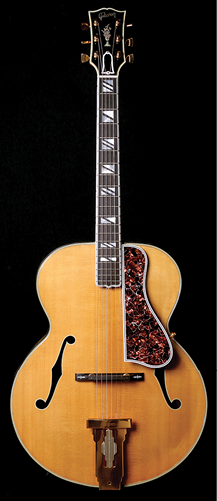

Gibson blond L-5. (Photos by Jen Angkahan)
I sold Jim two Gibsons that defy all features normally associated with their models. One is a blond Gibson 1961 acoustic L-5 non-cutaway. What makes this guitar unique is that the seventeen-inch L-5 body has been fused with the classic Super 400 fingerboard inlays and a marbleized Super 400 pickguard. In other words, the features on this guitar combine the best of both models. Yet the most unusual feature is the guitar’s black binding, which makes the blond finish just pop out by its beautiful contrast.
By 1961, Gibson stopped making L-5 non-cutaways. In Gibson’s ledger, the guitar was shipped in 1961 to Japan. This could mean the owner might have possibly been in the military or might have been an American expatriate.
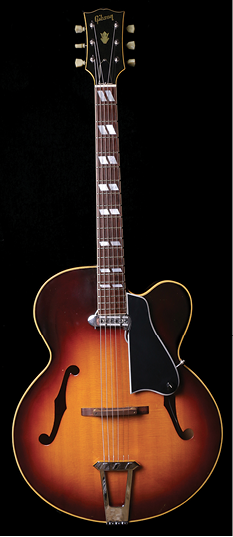
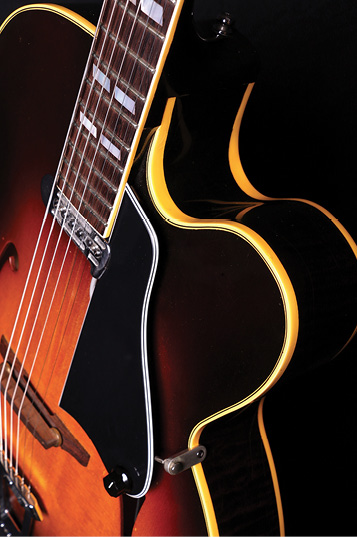
Gibson L-7C Special. (Photos by Jen Angkahan)
The second guitar is a gorgeous Gibson L-7C with a sunburst finish. What makes this guitar unusual is the shallow depth of the body. It is basically the depth of a Byrdland. I have seen L-5CTs with thin bodies, which are referred to as the George Goebel models. The L-5CTs are extremely rare, but in all my years I have never seen an L-7CT with the thin body. The guitar is not labeled L-7CT, so I believe this was probably a one-of-a-kind custom order.
I’ll let Jim Fox tell you about it, in his own words: “Dropping by Norm’s store is always fun and a regular thing for many of the players around LA. Everyone there is there because they dig guitars. Perfect! I dropped by one day around 2003 and Norm said, ‘I got something you should see.’ He has special places for special guitars, some very secret, but this one case was under his desk in his private office. Out came this old, brown Lifton case with the soft, pink lining, but then it got bizarre. An acoustic L-5, the one Norm just described. My mind became cloudy and confused. Being very tuned in to this type of guitar, I hit a disconnect from reality. Many of the appointments on this instrument were opposite of normal, but it was spectacular!
“I said, ‘Norm, what is it? Is it all-original? When did they make it? How did this happen?’ On top of all this, it sounded gorgeous and was in mint condition, with a perfect oval neck and consistent sounding in all registers.
“He told me. ‘Not for sale, and if it were for sale it would be crazy.’ He just wanted me to check it out, knowing I dig archtops so much.
“CUT! Approximately three years later, I get a voice message from Norm. ‘Jim, I’ve got a real cool L-7. Very different, and I’m letting a few of the cats know about it. It’s a ‘player.’
“I was in the neighborhood and stopped in. My good friend and great player Jon Kurnick was there checking out this thin L-7, which states ‘L-7C Spec’ on the interior label. I started playing this ultra-cool guitar when Jon says, ‘Hey Jim, you should buy it.’
“I loved how he was trying to spend my money and egg me on, so I quipped, ‘Screw you, Jon, you buy it.’
“He says, ‘It’s a ‘one-off’ and you’ll never see another like it.’
“Game on. I said, ‘Jon, if you want to know about super-cool one-off archtops, ask Norman about his L-5!’
“Jon said, ‘Norm, tell me about this L-5.’
“‘What L-5?’ said Norm.
“‘The crazy blond one.’
“‘Oh, that one! It’s in my office under my desk. I don’t think I’ve shown it to anyone since you saw it.’
“‘That was at least three years ago,’ I reminded him. Out comes the L-5, you know this part by now. Jon is stunned like a deer in the headlights. Keep in mind that there are other customers wandering around, looking at regular stuff and pretending to ignore this little board meeting. After some playing and unintelligible chatter, speaking in tongues, perspiration, giggling, et cetera, Jon says once again, ‘Hey, Jim, you should buy it.’
“I answered the predictable, ‘Screw you again, Jon.’ Two weeks later, with the blessing and encouragement of my wife, I bought both guitars. I cannot remember every date or appearance made with them, but the L-5 worked on my CD Natural Blonde, a Big Bad Voodoo Daddy record, a Frank Sinatra Jr. record, and a Steve Lawrence record, to name a few. The L-7 can be heard on Big Bad Voodoo Daddy’s recording of, ‘Give Me That Wine.’ It’s a great blues guitar and has remarkable acoustic power, especially for a thin-line. It’s often with me for sessions because this guitar will do anything well.
“A quick L-5 side note: I agree with Norman that Gibson should appoint some guitars this way. It’s stunning and incorporates some of the coolest features, visually. I have been terrified that this insanely beautiful centerfold L-5 would be scratched or damaged in the workplace. Studios and stages are often cramped and treacherous. I showed it to a friend who is very passionate about this stuff, like me, and he really took to it, so it now resides in the remarkable Ray Sherr Collection.”
•••
Another custom order or one of a kind is a Gibson L-4CE that recently crossed my path. This guitar is extremely rare in original black finish with a Charlie Christian Pickup. When I first looked at this guitar my initial reaction was, this can’t be right. When I looked at the label inside the guitar, I discovered it read L-4CE. The E means factory electric. There are many L-4Cs but very, very few L-4CEs. The L-4C is the same body as the ES-175, but the top is solid spruce. The ES-175 is a ply-maple pressed top. The inlay pattern on the neck, the crown on the headstock, and all other features are identical. The body is sixteen inches, and the scale length is also identical to the 175.
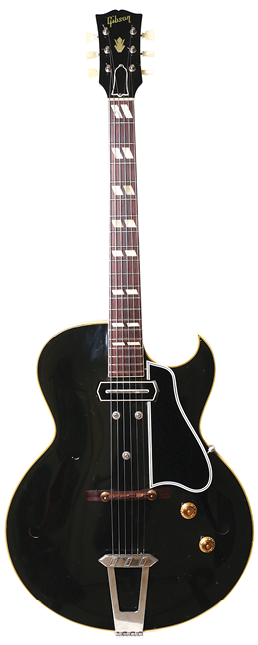
Gibson L-4CE. (Photo by Jen Angkahan)
It is known that the brilliant British jazz guitarist John McLaughlin used a black L-4CE on all of his sixties’ session work. I have looked all over to find a photograph of him with this guitar (just in case) to no avail.
It is known that the brilliant British jazz guitarist John McLaughlin used a black L-4CE on all of his sixties’ session work. I have looked all over to find a photograph of him with this guitar (just in case) to no avail.
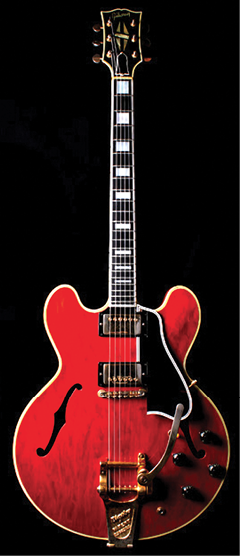
Gibson ES-355 Mono with Byrdland short scale. (Photo by Jen Angkahan)
I purchased this guitar and sold it to my good friend and fellow archtop obsessive, co-writer David Yorkin. I feel this guitar is super-appropriate for this chapter. I assure you it sounds incredible with that Charlie Christian Pickup.
•••
Mysterious Gibson “one-offs” weren’t only limited to archtops. At a trade show a number of years ago, I stumbled across a stunning mono ES-355 on display. The price was so high I just kept walking past it, thinking, I would love to own it but would rather not have the guy take a swing at me by making a lower offer.
Personally, I love the mono version of the 355 for its simplicity. Sure stereo instruments produce a great sound, but the sound path on mono guitars to the amp has less obstruction and is more “pure” to my ears.
After walking by the guitar for two days, I couldn’t take it anymore. I figured, what the hell, and I chatted up the owner. I told him it was cool to be optimistic about putting a figure on a guitar, but this price seemed slightly delusional. However, if he really wanted to make a deal . . .
I took a quick look at the guitar and made an offer. After a bit of negotiation, we found some middle ground. Of course, I had to inspect it. First order of business was opening up the pickups to make sure they were P.A.F.s. This is a customary procedure. I need to be able to represent any instrument I sell accurately. (I have never been in a lawsuit, and I want to keep it that way!) After everything checked out, I paid the man and left with my acquisition. I packed it up with all the other gear I bought and got everything ready for shipping home.
A few days later, everything arrived in one piece, and I began inventorying the new stuff and photographing it for my website. However, when I looked closely at the guitar, I realized something was very strange. The pickup placement on the guitar was closer than the usual distance between the pickups! After picking it up and playing it, I realized that the scale length of the guitar was actually shorter than other standard Gibsons.
I pulled out my tape and measured the scale. I discovered that the guitar actually had a Byrdland scale. The regular scale of an ES-355 is 24 3/4, but this guitar had the very unusual scale length of 23 1/2. I had never seen a semisolid Gibson ever with this feature. It had to mean that the 355 was a one of a kind custom order!
It was pretty ironic because in my haste to buy it, I overlooked the most interesting thing about it. Everything else about the guitar was correct—the finish, the hardware, et cetera, but because I never even played the guitar, the scale length just got right by me! Usually I am a lot more careful about these things, but I was so stoked about getting it, I overlooked this pretty big detail. Lesson learned. I now take a little more time to examine all aspects of a potential sale. In this particular case, I got very, very lucky!
I sold this guitar to a good friend of mine, who resides in Canada. And if I’m still lucky, someday I hope to possibly re-broker this killer one-of-a-kind instrument.